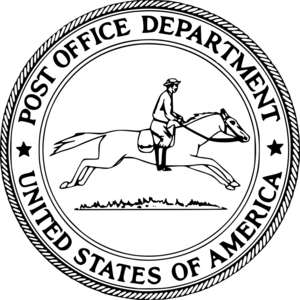History of United States postage rates facts for kids
Imagine sending a letter across the country! The way mail is delivered in the United States has changed a lot over time, just like the country itself. In the very beginning, the price you paid to send a letter depended on how far it was going. But by the mid-1800s, the price became the same no matter the distance.
For many years, postage prices stayed pretty much the same. Then, starting in 1968, the price would go up a little bit every few years. Even with these small increases, the actual value of a first-class stamp (when you compare it to how much things cost) has stayed quite steady.
The old Post Office logo used to show a man riding a horse, even when trains and then trucks started carrying the mail. In 1970, the Post Office became the Postal Service. Now, a group called the Postal Regulatory Commission helps decide the prices, with some help from Congress. By 1975, sending mail by air became the normal way to do it. Today, prices can even change slightly based on how big your letter is, especially if it's too large for the sorting machines!
Early Mail Prices (Before 1847)
The first rules for mail prices in the United States were made by Congress and signed into law by President George Washington in 1792. Back then, the price of sending a letter depended on how far it needed to travel. This was called a "distance zone" system.
Later, around 1847, special prices were set for mail going to or from the Pacific Coast. If your letter was bigger, you might have to pay "double" or "triple" the normal rate. There were also extra fees for mail sent by ship, like letters going to Hawaii. These ship fees were charged per letter, not by weight. The United States started using its first postage stamps in 1847. Before that, postal workers would write the price, date, and origin of the letter by hand on the envelope.
How Mail Prices Are Set Today
Since 1970, the prices for sending mail in the U.S. have been set by the Postal Regulatory Commission. This group makes sure the prices are fair and help the Postal Service run smoothly.
A Look at Past Mail Prices
Over the years, the price of sending a first-class letter has changed many times. For example, in 1863, it cost 6 cents to send a letter. By 1885, it dropped to 2 cents! During World War I, the price went up to 3 cents, but then it dropped back down after the war.
In the 1950s, a stamp cost 3 cents, then 4 cents in 1958. By 1971, it was 8 cents. A big change happened in 1975 when all domestic first-class mail started going by air, and the price jumped to 13 cents.
Since 2007, the Postal Service introduced "Forever stamps." These stamps are special because they are always worth the current first-class postage rate, no matter how much the price goes up in the future. This means you can buy them now and use them anytime! Also, around this time, prices started to be different for letters and packages.
If you look at the graph, you can see that while the actual price of a stamp has gone up, the price adjusted for inflation has stayed pretty steady. This means that compared to how much other things cost, a stamp hasn't gotten much more expensive over the years. For example, a jump from 2 cents to 3 cents in 1932 was a huge 50% increase back then!



